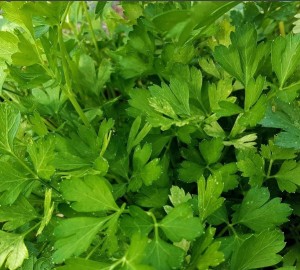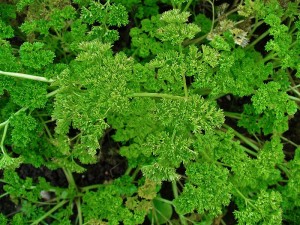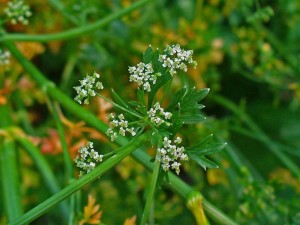
Flat Leaf Parsley
Parsley, that ubiquitous culinary ingredient and garnish comes in three varieties: the familiar flat leaf or Italian parsley (Petroselinum crispum neapolitanum), the curly leaf (Petroselinum crispum crispum) and root parsley (Petroselinum crispum tuberosum). All three are members of the carrot family.
Mediterranean, Middle Eastern and American cuisines all make extensive use of parsley. Flat leaf parsley is usually used in cooking or chopped and sprinkled raw on top of dishes. Curly leaf parsley is used as a garnish, to enhance the appearance of food. Root parsley is eaten as a vegetable in Central and Eastern Europe, either cooked in soups and stews or eaten raw like carrots.
All three cultivars are rich sources of antioxidants, Vitamins A and C and iron. In normal quantities in food, parsley is safe but in excessive amounts, it should be avoided by pregnant women in whom it could induce labor.

Curly Leaf Parsley
You will have to share your parsley with swallowtail butterflies. Parsley is the host plant for their caterpillars. Plant a little extra so that there will be enough for you and the caterpillars!
Parsley is a biennial plant that is native to the Mediterranean region. The first year, it sends up a rosette of leaves. The second year, the plants flower June through August. Once the flowers appear, the leaves become too bitter to use. Allow the flowers to mature into seeds to attract birds such as goldfinches.
In colder North American areas (zones 3 through 6), parsley is sometimes grown as an annual because it doesn’t always survive the frigid winters. In the South, parsley is best grown during the mild winter because it doesn’t stand up well to the intense heat of southern summers.

Root Parsley
Parsley prefers full sun but will tolerate a little shade. It should be grown in rich, moist, well-drained soil. Flat leaf parsley plants are tall (2- to 3-feet) and can become gangly. Curly parsley is more compact, growing 8- to 14-inches tall. It is often used as a border in the garden. The foliage of root parsley grows to 18- to 24-inches tall with a root that is 6- to 12- inches long.
Parsley is easily grown from seed although germination takes a while, anywhere from 4 to 6 weeks. You can hurry it along by soaking your seeds for a few hours or overnight prior to sowing. To direct sow your seeds, sow them in the spring 3 to 4 weeks before your last frost date. Don’t worry if you get an early frost, parsley withstands the cold. Indoors, you want to start your seeds 6 to 8 weeks before your last frost date. Whether sowing indoors or outdoors, plant the seeds 1/8 inch deep and keep the seeds moist until germination. Seedlings can be transplanted outdoors when they are 2- to 3-inches tall.

Parsley Flowers
When harvesting parsley, take only the outer leaves, cutting the stems to the ground, leaving the center leaves which are actively growing and the growing tip. Harvesting the center or actively growing leaves could weaken or kill your plants. It is best to use freshly harvested leaves right away but if you can’t, place them in a glass of water and store them in the refrigerator until you are ready to use them the same day.
To harvest root parsley, dig up the entire root with the foliage. Remove the foliage and store the root in damp sand just as you would carrots. You can also leave the roots in the ground all winter and harvest them in the spring like parsnips.
Parsley can be dried although it won’t be as flavorful. You can hang a bunch of parsley upside down in a dark, cool, well-ventilated space or spread the leaves in a single layer on a screen. Alternatively, you can dry the leaves in the oven, 100⁰F to 110⁰F for 20 minutes. Store your dried leaves in a tightly sealed container in a cool, dark place. Dried leaves will keep for up to a year. Parsley can also be frozen and stored in plastic bags in your freezer for up to a year.

